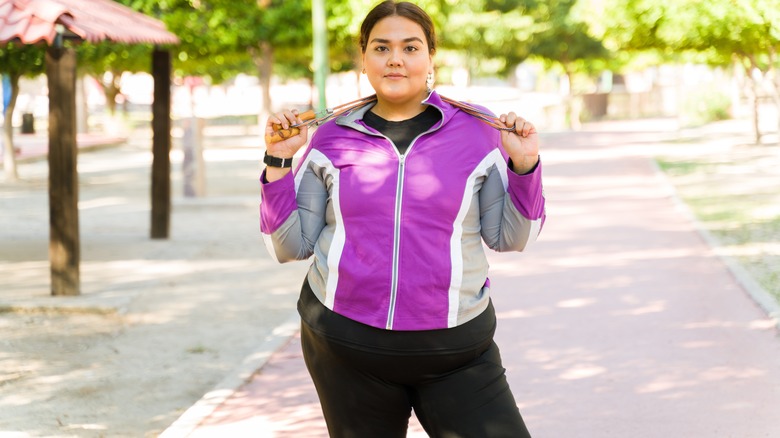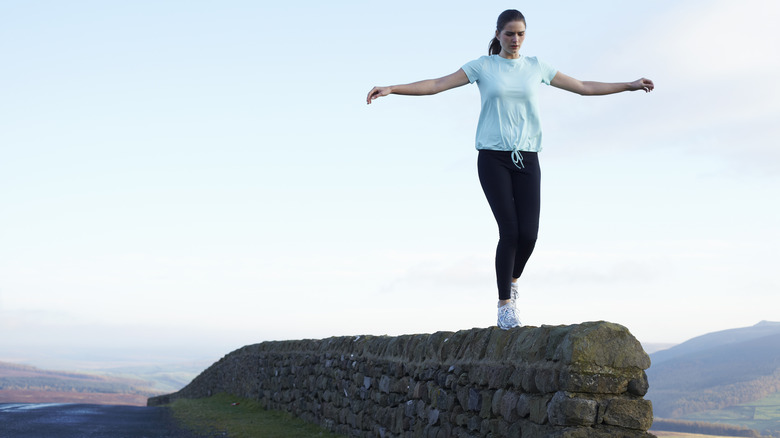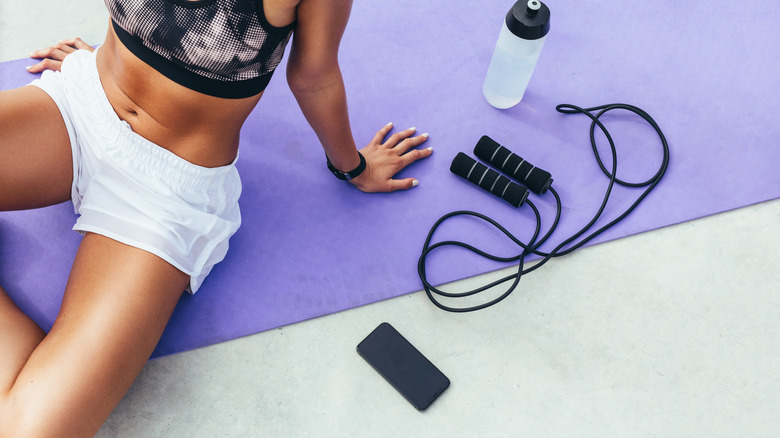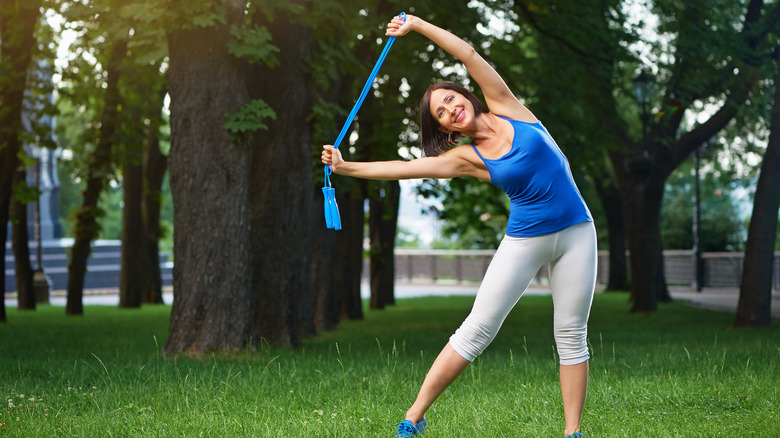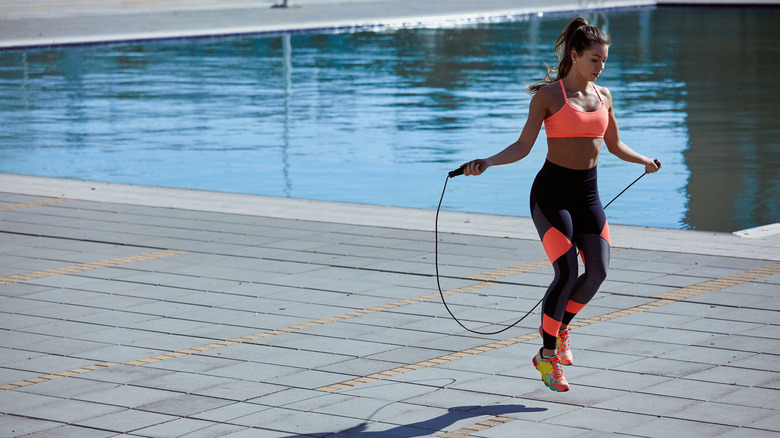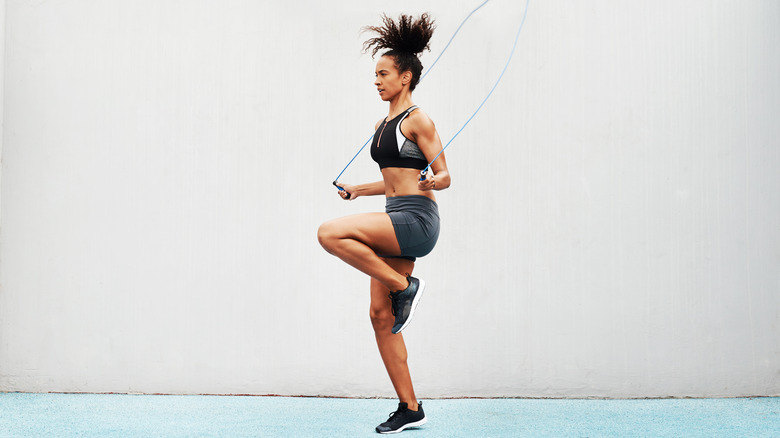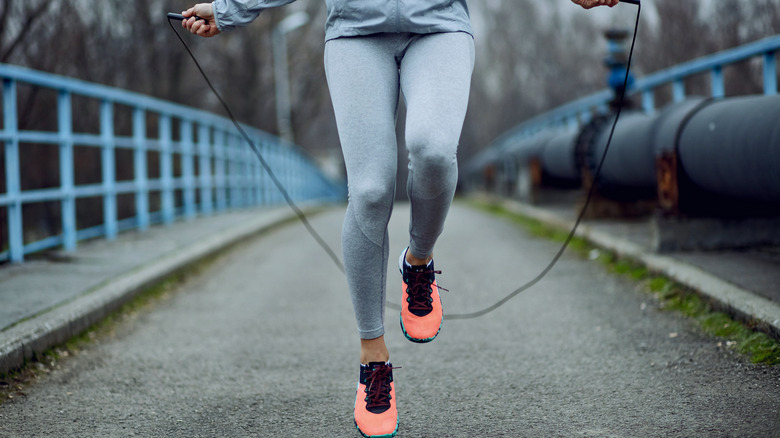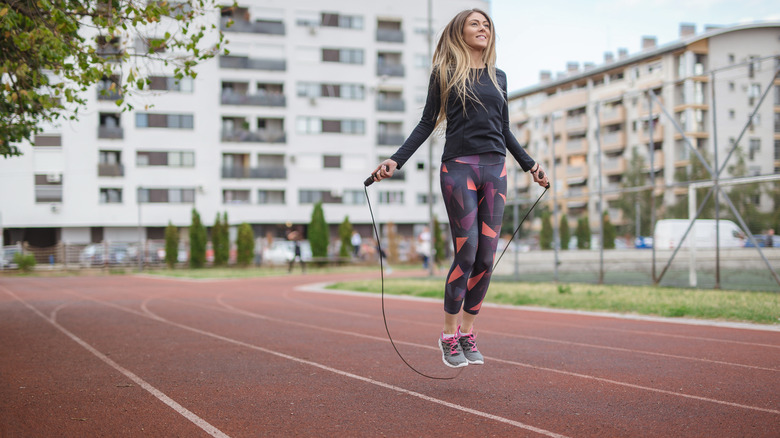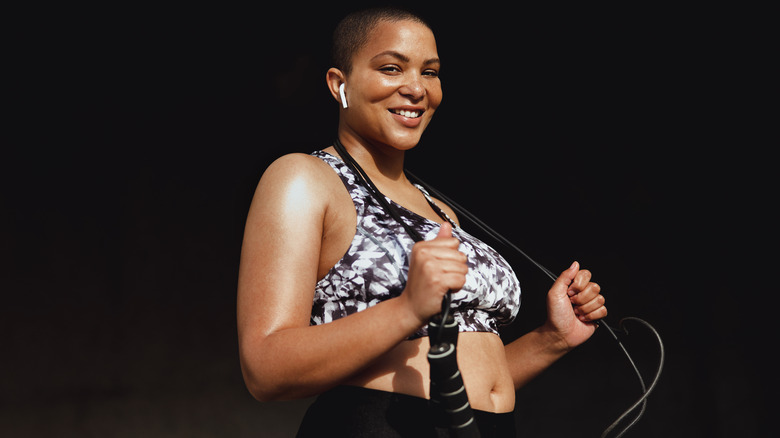All The Benefits Of Adding Jumping Rope To Your Workout
You've probably thought of dusting off the old jump rope many times as an adult. This could be because the exercise stirs up childhood memories. It probably felt like you could fly if you were good at performing some rope jumping tricks. And if you weren't, the struggle of learning how to jump rope is hard to forget. Whatever the case, jumping rope is an appealing activity not only meant for children. Almost anyone can pick up a jump rope and have fun with it. Forms of physical activity can improve your mental and physical health, make you stronger, reduce the risk of certain diseases, and improve the quality of your life (via the Centers for Disease Control and Prevention).
But rope jumping has a special appeal. It may seem like a simple exercise, but it has perks that you can't get from any other workout. For one, jumping rope meets you at your fitness level. Whether you are new to working out or exercising is your brand, you're bound to get something out of jumping rope. It can be a good warmup routine or your whole workout. Also? Your jumping sessions don't have to be boring, as you can also experiment with various techniques.
If you're considering jumping rope as part of your workout routine or to simply connect with your inner child, here are the benefits of the exercise that make it worth a try.
It's a good way to lose weight
If you are looking for a good exercise for weight loss, then jumping those calories off might be the way to go. The beloved playground activity can help to prevent childhood obesity. In a study published in the journal Children, jumping rope for 30 minutes three times a week significantly reduced the body mass index of the children studied over a nine-week period. Having a high BMI doesn't necessarily mean a person is unhealthy. The measurement is used to determine the level of body fat that may predispose a person to an illness (per CDC). It is calculated based on weight and height.
Another study with prehypertensive, obese, adolescent girls published in the Journal of Pediatric Endocrinology & Metabolism found that 12 weeks of jumping rope improved body composition. This parameter assesses the amount of actual fat that makes up a person's weight. During the 12-week study, the girls reduced their body fat percentage and waist circumference, and their blood pressure went down. Jumping rope for weight loss is great for adults too. One study published in Nutrients had participants jumping rope for eight weeks and restricting calories. The participants who fully complied with the study lost weight.
Jumping rope can help you lose weight because it burns a high amount of calories. For example, a person weighing 155 pounds who jumps rope for 30 minutes can burn up to 372 calories. And the more you weigh, the more calories you'll burn when you work out.
It improves your balance and coordination
If you often feel wobbly on your feet, jumping rope might give you that much desired balance and coordination. It's one of the methods used to develop these skills among athletes (per a study published in the Journal of Sports Science and Medicine).
Jumping rope is capable of improving balance and coordination because of the nature of the exercise. For every jump, your body requires balance so that you can repeatedly take off and land on your feet. Also, it takes some level of coordination to do this while rotating your arms. Jumping rope also develops muscles in your legs, waist, abdomen, and back, making them support your body weight better (per a study published in Scientific Reports). And it improves your ability to control your body's muscles when you move. Both studies report an improvement in balance and coordination among participants. The first study included preadolescent soccer players and the second, adolescent tennis players.
If you take up jumping rope, your balance and coordination are bound to improve.
You would have stronger muscles
Maybe the idea of lifting heavy weights to get stronger doesn't sit right with you. Jumping rope might be an easier method for building the muscle strength you've wished for. Why do you think jumping rope is famous among boxers?
Jumping rope develops lower body muscle strength which is necessary to dole out forceful punches. This study published in Frontiers in Bioengineering and Biotechnology found that an eight-week jump rope training program provided gains to punching force among amateur high school boxers. Jumping rope activates muscles all over your body, including your calves, a group often overlooked in strength training workouts. You also work those thigh and hip muscles like your quads, glutes, and hamstrings. As for your upper body, your shoulder, back, and abs get a good workout from swinging that rope.
Your form matters if you want to get better activation of the muscles. You need to pull your shoulder blades in and down and engage your core. Jumping rope also works the muscles of your arms and hands, which improves your grip. You can also target specific muscles by switching things up a little. For example, adding some single-leg jumps will give your glutes more work to do. And side-to-side jumps will activate your oblique muscles. It's important, though, to build new jumping techniques gradually to avoid injury.
Jumping rope is easier on your joints than you think
You might see jumping rope as an intense exercise that is bound to hurt your knees or ankles. But jumping rope may be less hard on your joints than running. This was observed in a study with female participants published in the Journal of Bodywork and Movement Therapies. Plus, with jumping rope, you're free to stay put. Running is great, but it might not always be convenient.
Compared to running, you take shorter steps when you skip and make less impact with the ground. Your joints also perform less work since your legs are extended when you jump rope. This all means that there is less load on them (per a study published Gait Posture). The researchers observed lower knee joint impact when jumping rope versus running. They also found that jumping rope had a higher benefit as an aerobic exercise compared to running. They suggest that jumping rope may be better for those who are worried about joint injuries from running.
As with any activity, there is still some risk of injury when you jump rope, but you can reduce it by using the right technique. Generally, you want to avoid jumping too high off the ground. And opting for a softer surface to exercise and better shoes can help you cushion the impact. It's always a good idea to not overwork your body, especially if you're concerned about your joints.
It improves your cognitive abilities
Your cognitive abilities represent how well your brain performs tasks. These include perception, visual processing, spacial processing, problem solving, attention, memory, and recall (via Sharp Brains). Your cognitive abilities are not set in stone and can be improved. Having good cognitive abilities makes tackling school work or your job easier.
One of the ways to improve cognitive abilities is by exercising. Regular physical activity has been found to improve the ability to learn and remember, as well as self-control. It also counteracts the mental decline associated with aging (via a review published in Neuroscience and Biobehavioral Reviews). What's more, exercising provides long-term cognitive benefits by causing changes to the brain.
A study published in the International Journal of Environmental Research and Public Health found that jumping rope improved math skills among students. The authors suggest that the rhythmic movements, body coordination, and repeated contact with the ground creates a state of mind that favors learning. Additionally, the exercise increases blood flow to the brain which helps with learning. Another study published in Brain Sciences found that rhythmic rope jumping improved attention and reduced the anxiety levels of the young adults that participated.
It increases bone density
Just like exercising can strengthen your muscles, your bone mineral density also gets a boost from the right workouts. Activity can trigger the growth of stronger bones and maintain bone strength if you're older. Jumping rope helps build bone mass because it's done against gravity. With the exercise, your legs bear your body weight and your bones have to work hard to carry it (via the OrthoInfo).
Building bone density is important because after menopause, women have an increased risk of osteoporosis, a condition that causes weak bones. A study published in Sports Medicine found that jumping exercises improved bone mineral density, especially at the hip. This study was carried out among premenopausal women with a high risk of bone disease. Another study among premenopausal women published in the Journal of Sports Medicine and Physical Fitness compared the effect of resistance training and power exercises like jumping rope, skipping, and hopping on bone mineral density. They found that after 48 weeks of these exercises, both forms of exercise helped maintain bone density. So jumping rope may be a good alternative to resistance exercises for maintaining bone density.
A study published in Journal of Bone and Mineral Metabolism also shows that jumping rope improves bone density. The participants were artistic swimmers who also have a risk of weak bones because they spend much time in water, which carries their body weight. The intervention used in the study was a combination of rope jumping and whole-body vibration.
It enhances athletic performance
Jumping rope is usually added to athletes' training routines to improve fitness and make them better at their sports. Jumping rope is good at improving footwork, so it helps with sports that require bouncing on the feet such as running, jumping, hopping, or sports that require a rapid change in direction. When jumping rope, your muscles stretch as you jump and shorten when you land. This is repeated when you jump rope in what is known as the stretch-shortening cycle (per research published in the Journal of Sport and Health Science).
This stretch-shortening cycle helps you produce explosive jumping movements, kind of like you have a spring in your legs. And jumping rope builds this ability by strengthening your leg muscles and improving their ability to store energy, according to K Bands Training.
The many other benefits of jumping rope make it an attractive exercise for any athlete. Jumping rope improves balance and coordination, tones muscles, helps with weight management, and improves physical fitness overall. These all help to improve athletic performance. If you've never jumped rope, you get the added benefit of mastering a new skill. This is always good as it makes you versatile as an athlete.
It helps to reduce your risk of cardiovascular diseases
One of the reasons everyone is encouraged to exercise is that it reduces the risk of cardiovascular diseases. Exercising improves your blood circulation, leading to lower blood pressure, per a paper in Frontiers in Cardiovascular Medicine. Exercising also reduces your risk of developing cardiovascular diseases like stroke, atherosclerosis, and heart disease. A sedentary lifestyle can lead to problems like these. Exercising can reduce body fat and blood sugar, and serves as an added therapy for people with cardiovascular diseases (via this review published in Frontiers in Cardiovascular Medicine).
Jumping rope is good exercise to pick up if you are at risk of cardiovascular diseases. In a study published in the European Journal of Applied Physiology, 12 weeks of jumping rope reduced the risk of cardiovascular diseases in prehypertensive adolescent girls. Before you take up rope jumping, you should always check in with your doctor to make sure it's safe for you, especially if you have a health condition.
It boosts your aerobic fitness
Your aerobic fitness reflects the ability of your heart and lungs to supply blood-containing oxygen to your muscles while you exercise. The ability of your exercising muscles to use the oxygen to produce energy for the workout forms part of aerobic fitness (per this review published in Circulation). It is described by many names such as cardiorespiratory fitness, cardiorespiratory endurance, cardiovascular fitness, or aerobic capacity. Your aerobic fitness is one of the determinants of your overall physical fitness, others being muscular strength, flexibility, and body composition.
A good way to improve your aerobic fitness is by exercising. This is important because it makes it easier for your body to get oxygen while you exercise, improves your ability to perform daily activities without tiring easily, reduces your risk of disease, and improves your mental health (via this study published in the International Journal of Human Movement Science). One of the ways to measure aerobic fitness is to measure VO2 max. This is the maximum rate of oxygen consumption by the body during exercise. The study found that multistage jump rope training improved the VO2 max of the participants. Another study published in the Journal of Physical Therapy Science found an increase in vital capacity (a measure of your ability to take deep breaths) following four weeks of music jump rope exercises.
You can improve your walking and running speed
If you add jumping rope to your workout, your legs could get stronger. And this can make activities that have you on your feet a cakewalk. Additionally, jumping rope can help you run better, and it's often used to train runners. A study published in the Journal of Strength and Conditioning Research suggests that the jumping technique of double-unders (where the rope passes under the feet twice per rotation instead of once) can be used to improve sprint ability in children. Children who did better at double-unders were faster during a 20-meter sprint. Jumping rope has also been highlighted as a good warm-up exercise for runners in one study published in the international Journal of Sports Psychology and Performance. The researchers observed that five minutes of jumping rope as a warm-up improved running and jumping performance among amateur endurance runners.
If you find that you get winded from walking or that running a short distance feels like it's taking forever, adding jump rope exercises to your workout might be just what you need. This can be really helpful if you have to be on your feet a lot.
It's a fun way to exercise
If you view exercise as a punishment instead of an enjoyable activity, jumping rope may change your mind. First, it's fun for many reasons. For many people, it brings nostalgic childhood memories. Jumping can be a freeing experience once you get in the groove. If you find mastering new physical skills enjoyable, then this exercise is for you. Plus, it's an easy workout you can do at home.
If you jump rope frequently, you're bound to jump faster and better with time. It can also be fun to watch an exercise video and learn new jumping techniques, just to switch things up. This can make each jump rope session something to look forward to.
Jumping rope can serve as a warm-up to get your mind and body ready for a workout. Or, it can be your whole workout, as it's a vigorous form of exercise. And adults are encouraged to perform at least 75 minutes of vigorous exercise or 150 minutes of moderate exercise each week (per the CDC). What's more, jumping rope doesn't require fancy or expensive equipment. You just need a good rope, appropriate shoes, floors that are not too hard, and you're good to go.

